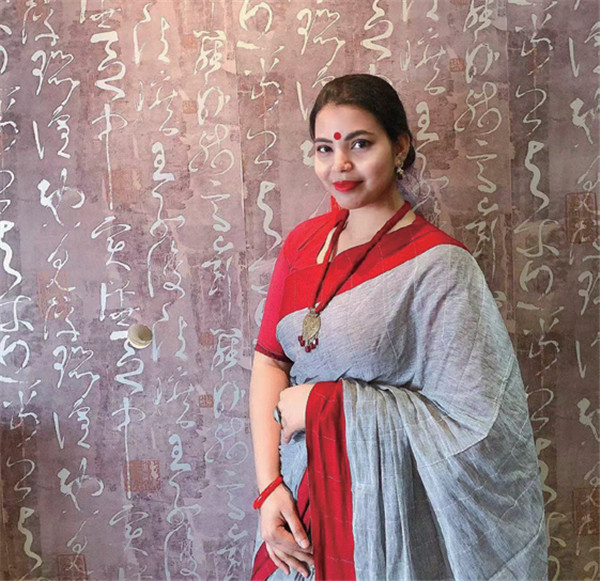我與中國的“茶之緣”
〔 孟加拉國 〕 妮魯 貴州大學

兩位仙氣飄飄的茶藝師,在悠揚沉靜的古琴聲中,調息靜心,行雲流水般地展示著泡好一壺茶的藝術……觀眾們都沉浸在若隱若現的絲絲茶香之中,而我,也徹底淪陷在中國茶藝帶來的視覺享受裏,久久不能平靜。
這就是我第一次真正意義上欣賞中國茶藝表演的場景,我想也是因為這次經歷開啟了我與中國的“茶之緣”。其實很早就聽説,對中國人而言,日常生活最重要的七樣東西是:柴、米、油、鹽、醬、醋、茶,這前六樣我倒是能明白,畢竟“民以食為天”,可是這“茶”到底為什麼對中國人如此之重要呢?

妮魯參加茶藝活動
在來中國之前,我也聽我的導師説過,中國的茶有著悠久的歷史,中國的茶文化源遠流長。來到貴州大學以後,艾莎姐姐告訴我,作為一名漢語國際教育專業的碩士研究生,在這三年裏我們會學到很多的中國傳統才藝,其中就有中國茶藝。聽到這個消息,讓飲茶“小白”的我來説,歡呼雀躍。聽説會有一個喜歡穿漢服和旗袍,特別有氣質的、仙女般的老師來教我們茶藝,我當時就充滿了期待。可是當我真正看到什麼叫茶藝之後,我也逐漸開始明白,中國人之所以看重“茶”,這不只是一種飲品,也是一種生活,一種精神,更是一種文化。

貴州大學校園 / 妮魯提供
後來就是期待已久的茶藝課了,坐在教室裏的我,看著老師的一顰一笑,聽著她輕柔的話語,關於茶的種種知識就這樣不知不覺地進入我的腦海和心裏。我開始從一個全新的角度去了解中國的茶文化,知道了不同茶的名字和産地,比如浙江的龍井、雲南的普洱、武夷山的大紅袍,還有我身在貴州,原來這裡也有許多好茶,像都勻毛尖、湄潭翠芽都是這裡老百姓的摯愛;我也了解到原來茶葉還有不同的製作工藝,採摘、曬青、做青、殺青等。但是真正吸引著我的還是中國茶藝,我也想像老師一樣優雅、沉穩,並且“正確”地沏上一壺茶,致長輩,敬客人,給自己。

中國風光 / 妮魯提供
我開始潛心向老師學習茶藝,逐漸掌握了生活茶藝和花茶茶藝,這才知道原來泡茶也有泡茶的藝術,茶葉的多少、茶具的選擇、水的溫度、泡茶的手勢,甚至品茶的時間都影響著茶的味道。為了讓看我泡茶的人有最好的享受,我還學了怎麼拿好杯子,泡茶的時候應該怎麼坐,而手又應該放在哪……慢慢地,我終於開始了解,為什麼老師告訴我泡茶是一門藝術,也是一門學問,更是一種哲學。每個人泡茶方式不一樣,看一個人泡茶,喝一個人泡的茶,你其實可以感受他的心情如何,他的性格又怎樣。這簡直太不可思議了,難怪古往今來,這麼多詩詞文學作品都談論到茶。幾千年的沉澱註定了“茶文化”之深厚,而我,像一條小魚暢遊于中國的茶海,自由且歡暢,越了解越好奇,越好奇越探索。我的朋友們經常問我:“妮魯,你為什麼那麼喜歡中國茶呢?你怎麼可以把中國茶泡得那麼好?”我想,原因其實既直接又簡單,就是因為愛吧!因為我愛中國茶,我也愛中國!愛中國的文化,愛我在中國遇到的這些可愛的人,愛中國教給我可以陪伴我一生的東西。

貴州大學新區校門 / 妮魯提供
仔細想想,其實每個中國人不都很好地詮釋著中國茶文化嗎?你看,多少中國人開始一天工作之前泡上一壺茶,陪自己開始一天的奮鬥;又有多少中國人,休憩之時,倒上一杯茶,捧一本書,自斟自飲;又有多少中國人叫上三五好友,以茶會友,聊盡生活的甘苦……就像茶一樣,不用計較好茶、壞茶,只要合適的水溫、合適的茶具、合適的環境,這就是中國人的情趣。那什麼是合適?可能自己覺得合適就是合適吧。再聯想到2020年1月的新冠肺炎疫情,多少中國人被困家中,沒有怨聲載道,沒有心急如焚,而可能只是和家人一起泡一壺濃茶,關心著疫情的發展,聞一聞熱茶的香氣,靜靜地等待春暖花開,這難道不是茶的哲學,不是中國人的哲學嗎?

貴州大學閱湖與圖書館 / 妮魯提供
我很幸運,能夠在中國與茶邂逅,了解茶,學習茶,愛上茶。老師告訴我,茶有三品:一品感恩,二品知足,三品惜福。我願帶著茶的馨香、茶的文化、茶的哲學,將我與中國的“茶之緣”分享給更多想要了解中國茶的外國人,借用中國詩人白居易的詩句,“無由持一碗,寄與愛茶人”,願愛中國茶的你我、和中國結下茶緣的你我一起,以茶修身,茶悅人生!
My Love Knot of Chinese Tea
〔Bangladesh〕 Akter Nilu, Guizhou University
Under the melodious and placid music of guqin, a seven-stringed plucked Chinese instrument, two tea art masters with fairy spirit demonstrated how to make a pot of tea. Their performance is like floating clouds and flowing waters. With regulated breath and cleared mind, the audience were immersed in the faint fragrance of tea. I had completely fallen into the visual enjoyment brought by Chinese tea art and it was long time before I calmed down.
This was the first time I watched the Chinese tea art performance in its true sense. I think it was also this experience that started the “love knot” between China and me. In fact, I was told long time ago that for Chinese people, the seven most important things in daily life are firewood, rice, oil, salt, sauce, vinegar and tea. I can understand the first six items. After all, as an old Chinese saying says, “food is the most important thing for the people.” But why is the “tea” so important too?
Before coming to China, my tutor told me that Chinese tea has a long history and so does its culture. After being in Guizhou University, sister Ai Sha told me that as postgraduate students majoring in Chinese language teaching, we would learn a lot of traditional Chinese skills in three years, including tea art performance. As a beginner, I was very excited to hear this. I heard that there would be a fairy-like teacher who liked to wear Hanfu, or cheongsam, to teach us tea art. I was filled with anticipation at that time. But when I really saw what the tea art is, I gradually began to understand why Chinese people value “tea” so much. It is not just a drink, but a life style, spirit and culture.
Then came the long-awaited tea art class. Sitting in the classroom, I looked at the teacher’s smile and listened to her gentle words. All kinds of knowledge about tea came into my mind unconsciously. I began to understand China’s tea culture from a new perspective and learned the names and origins of different teas, such as Longjing in Zhejiang Province, Pu’er in Yunnan Province, Dahongpao in Wuyi Mountain. I was in Guizhou and it turned out that there are so many good teas here, such as Duyun Maojian and Meitan Cuiya, which are the favorites of local people. I also learned that there are different processing techniques for tea making, such as picking, drying, processing, fixation and so on. However, what really attracts me is the Chinese tea art performance. I also want to be as elegant and calm as the tea master, who can brew a pot of tea “in a right way” and serve them to the elders, the guests and herself.
I started to immerse myself into the tea art performance from the teacher and distinguished the difference between everyday tea drinking and the art of making tea. Only then did I realize that tea making is kind of art too. The amount of tea leaves, the choice of tea sets, the temperature of water, the movement of hands, and even the time of making tea will affect the taste of tea. I also learned how to hold the tea cup properly, how to sit while making tea and where to put my hands in order to give the best enjoyment to those watching me to make tea. I finally understand why the master told me that tea drinking is not only an art, but also a science and philosophy. Everyone makes tea in his own way. By watching a person make tea and drinking the tea he made, you can actually feel his mood and know his personality. It’s so incredible. No wonder so many poems and literary works through the ages tackled tea. Thousands of years of accumulation are bound to have the profound “tea culture”. I, like a small fish in the sea of Chinese tea, am swimming freely and happily. The more I understand, the more curious I am, and the more I explore. My friends often asked me, “Niru, why do you like Chinese tea so much ? How can you make Chinese tea so well?” I think the reason is direct and simple. It is because of love – I love Chinese tea. I love China and the culture of China. I love the warm people I met in China. The things I learned in China can accompany me for my whole life.
Ponder it carefully. Isn’t everyone in China a good interpreter of Chinese tea culture? There are so many Chinese people who choose to make a pot of tea before starting their daily work. The tea is a good company for their arduous job. Many Chinese people pour a cup of tea and read a book during their break time; and many Chinese people have a tea party with friends to share the joy and hardships of life… Just like tea, no matter it is good or bad, with the right water temperature, the right tea set and the right environment, everything will be right. This is the taste of Chinese people. So what is right? Possibly what you think right is right. During the COVID-19 pandemic starting from January 2020, many Chinese people were trapped at home but had no complaining and worrying. They may make a pot of strong tea and stay with family members. They did have concerns about the evolution of the epidemic but meanwhile they enjoyed the aroma of hot tea. They quietly waited as they believed that the spring would come and the flowers would bloom. Isn’t that the philosophy of tea, the philosophy of Chinese people?
I was very lucky to encounter tea in China, where I understand tea, study tea and love tea. Teachers told me that the tea can be tasted with three levels. The first is gratitude, the second contentment and the third happiness. I am willing to share “my love knot of Chinese tea,” including the fragrance, the culture and the philosophy of tea, with more foreigners who have interest in learning about Chinese tea. I would like to quote the poem of Bai Juyi, a famous Chinese poet, “There is no reason to hold a bowl of tea, which contains my deep feeling to the tea lovers.” I wish you and me, who love Chinese tea and set up the bond with China, unite together to cultivate ourselves with tea and enjoy life with tea!



